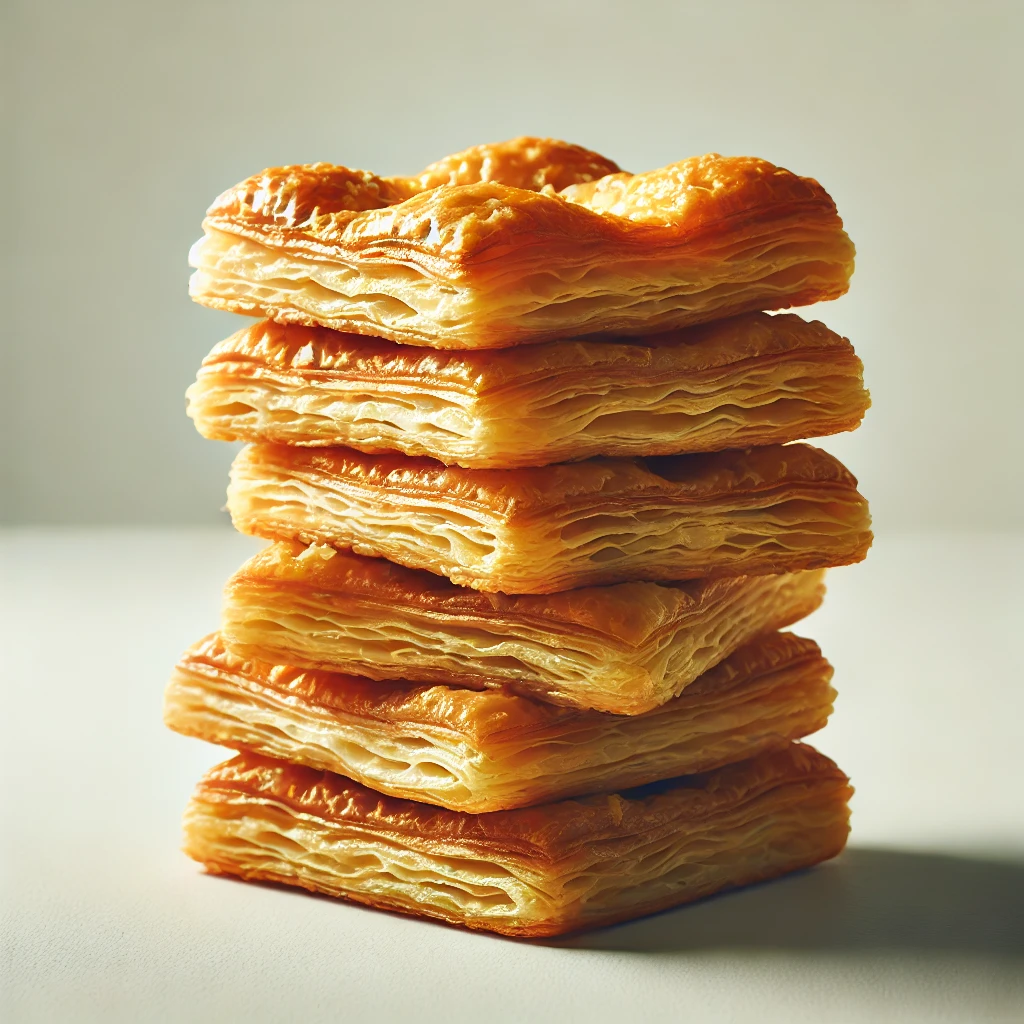1. Introduction
Craving those perfectly crisp and flaky layers of puff pastry but need to stick to a gluten-free diet? Gluten-free puff pastry has rescued many who have had to give up traditional pastries due to dietary restrictions. But achieving the right texture can be a bit tricky. This article includes everything you need to know, from understanding ingredients to mastering the technique.
2. What is Gluten Free Puff Pastry?
Gluten-free puff pastry is a modified version of the classic French pastry, specially formulated without wheat flour. While traditional puff pastry relies on gluten to create its signature layers, the gluten-free variant usecombinesternative flours and binding agents to mimic the structure. The result? A light, buttery, and flaky pastry that’s safe for those with gluten sensitivities or celiac disease.
3. Why Gluten Free? Understanding the Need
The rise in gluten-free diets stems from health conditions like celiac disease, gluten intolerance, or autoimmune disorders. Even those without diagnosed issues sometimes prefer a gluten-free lifestyle to reduce inflammation or improve gut health. As the demand grows, gluten-free options are becoming increasingly sophisticated, with puff pastry being a prime example.
For more on the benefits of going gluten-free, visit the Celiac Disease Foundation.
4. The Science Behind Puff Pastry
Puff pastry relies on the unique properties of gluten, which provides stretch and flexibility to the dough. The folding and layering process traps air, and as the pastry bakes, steam from the melting butter expands the layers, creating that heavenly rise. However, without gluten, bakers must get creative.
How Gluten Free Works:
To replicate this process in gluten-free puff pastry, bakers use ingredients like xanthan gum and psyllium husk to provide elasticity and structure. The goal is to form layers of dough and butter that expand beautifully in the oven.
5. Essential Ingredients in Gluten-Free Puff Pastry
The perfect gluten-free puff pastry requires a few key ingredients:
- Alternative Flours: Rice flour, almond flour, and tapioca starch are popular choices. These flours help to mimic the lightness of wheat flour.
- Binders: Xanthan gum, guar gum, or psyllium husk are essential to give the dough its necessary elasticity.
- Cold Butter: Keeping the butter cold is crucial for creating distinct layers. It’s recommended to freeze the butter cubes and even chill the mixing bowl.
6. Gluten-Free vs. Traditional Puff Pastry
There are significant differences between gluten-free and traditional puff pastry, primarily in terms of texture and workability.
Texture and Elasticity: Traditional puff pastry is highly elastic, making it easy to roll and fold. Gluten-free pastry is more fragile, prone to breaking, and requires a gentler touch.
Flavor: Some alternative flours introduce a nuttier flavor, which can add complexity to your pastry. Additionally, gluten-free pastry can feel heavier if not handled correctly.
| Aspect | Traditional Puff Pastry | Gluten Free Puff Pastry |
|---|---|---|
| Elasticity | High | Low |
| Workability | Easier | Trickier |
| Flavor | Neutral | Nutty or Sweet |
7. Detailed Step-by-Step Recipe
Creating gluten-free puff pastry at home requires precision and patience. Here’s how:
Ingredients:
- 2 1/2 cups gluten-free flour blend
- 1 teaspoon xanthan gum
- 1 teaspoon salt
- 1 cup very cold, unsalted butter, diced into small cubes
- 1 cup ice-cold water
Instructions:
- Mix the Dry Ingredients: In a large mixing bowl, whisk together the gluten-free flour blend, xanthan gum, and salt.
- Add the Butter: Work the cold butter into the flour using a pastry cutter or your fingertips until the mixture resembles coarse crumbs.
- Incorporate Water: Slowly add ice-cold water, a tablespoon at a time, gently mixing until the dough just comes together.
- Form and Chill: Shape the dough into a rectangle, wrap in plastic, and chill for 30 minutes.
- Roll and Fold: On a floured surface, roll the dough into a long rectangle. Fold into thirds like a letter and chill again. Repeat this process five times to create layers.
- Final Chill: Let the dough rest in the refrigerator for at least an hour before using.
8. Tips and Techniques for Flaky Layers
- Use Ice-Cold Ingredients: Ensure that your water, butter, and even flour are as cold as possible.
- Handle with Care: Overworking the dough can break the butter layers and result in a dense pastry.
- Rest and Chill: The dough must be chilled between each rolling session to solidify the butter.
9. Avoiding Common Pitfalls
Mistakes are easy to make, but knowing what to avoid can save your pastry:
- Melting Butter: If your butter melts into the dough, you’ll lose the flakiness. Work quickly in a cool environment.
- Overhydration: Adding too much water can make the dough sticky and difficult to roll.
- Wrong Flour Blend: Always use a high-quality gluten-free flour blend designed for baking.
For more troubleshooting tips, check out Serious Eats.
10. Popular Recipes Using Gluten-Free Puff Pastry
The beauty of gluten-free puff pastry lies in its versatility. Here are some recipe ideas:
- Savory Tarts: Load the pastry with goat cheese, caramelized onions, and fresh herbs.
- Breakfast Pastries: Fill with homemade jam or Nutella for a sweet breakfast treat.
- Mini Quiches: Use puff pastry as a base for bite-sized quiches, perfect for brunch or parties.
11. Storage and Freezing Tips
- Refrigeration: Store prepared dough in the fridge, wrapped in plastic, for up to three days.
- Freezing: To freeze, roll out the dough, wrap it tightly, and store it in a freezer-safe bag for up to three months. Thaw in the fridge before using.
12. The Health Benefits of a Gluten-Free Diet
For individuals with celiac disease, following a strict gluten-free diet is crucial. However, many people without celiac have reported improved digestion and reduced inflammation when avoiding gluten. It is important to always consult a healthcare provider before making any dietary changes.
Read our article on How to Transition to a Gluten-Free Lifestyle.
13. Where to Buy or Order Gluten-Free Puff Pastry
For those who prefer convenience, several brands sell ready-made gluten-free puff pastry:
- Schar: A popular brand known for reliable gluten-free products.
- GeeFree: Offers frozen gluten-free puff pastry sheets that are easy to use.
Many can be purchased online through retailers like Amazon or specialty grocery stores.
14. Making Gluten-Free Puff Pastry More Affordable
Buying pre-made gluten-free options can be pricey. To cut costs, consider these tips:
- Make in Bulk: Prepare and freeze large batches of dough.
- Buy Ingredients Wholesale: Purchase gluten-free flours and binders in bulk for discounts.
- DIY Flour Blends: To save money, create your flour blends at home.
15. Conclusion
Mastering gluten-free puff pastry is an art that comes with practice. The key is patience, precision, and a keen understanding of your ingredients. With these tips and techniques, you’ll soon be baking delicious, flaky pastries that no one will guess are gluten-free. Happy baking!

